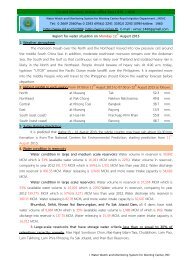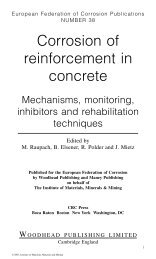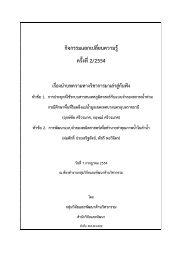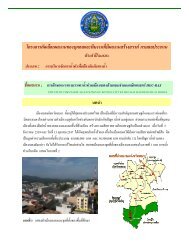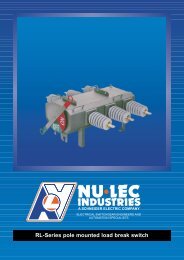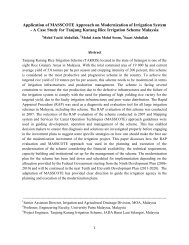- Page 3 and 4:
Also available from Taylor & Franci
- Page 5 and 6:
First published 1982by Surrey Unive
- Page 7 and 8:
viContents2.3 Theory, calibration a
- Page 9:
viiiContents7.5 Tests for freeze-th
- Page 12 and 13:
Prefacexiwish to study particular m
- Page 14 and 15:
Chapter 1Planning and interpretatio
- Page 16 and 17:
Planning and interpretation of in-s
- Page 18 and 19:
Planning and interpretation of in-s
- Page 20 and 21:
Planning and interpretation of in-s
- Page 22 and 23:
Planning and interpretation of in-s
- Page 24 and 25:
Planning and interpretation of in-s
- Page 26 and 27:
Planning and interpretation of in-s
- Page 28 and 29:
Planning and interpretation of in-s
- Page 30 and 31:
Planning and interpretation of in-s
- Page 32 and 33:
Planning and interpretation of in-s
- Page 34 and 35:
Planning and interpretation of in-s
- Page 36 and 37:
1.6 InterpretationPlanning and inte
- Page 38 and 39:
Planning and interpretation of in-s
- Page 40 and 41:
Planning and interpretation of in-s
- Page 42 and 43:
Planning and interpretation of in-s
- Page 44 and 45:
Planning and interpretation of in-s
- Page 46 and 47:
Planning and interpretation of in-s
- Page 48 and 49:
Planning and interpretation of in-s
- Page 50 and 51:
Surface hardness methods 37Figure 2
- Page 52 and 53:
Surface hardness methods 39Figure 2
- Page 54 and 55:
Surface hardness methods 41influenc
- Page 56 and 57:
Surface hardness methods 43cases ab
- Page 58 and 59:
2.3.2 CalibrationSurface hardness m
- Page 60 and 61:
Surface hardness methods 47Figure 2
- Page 62 and 63:
Surface hardness methods 49(i) Conc
- Page 64 and 65:
Chapter 3Ultrasonic pulse velocitym
- Page 66 and 67:
Ultrasonic pulse velocity methods 5
- Page 68 and 69:
Ultrasonic pulse velocity methods 5
- Page 70 and 71:
Ultrasonic pulse velocity methods 5
- Page 72 and 73:
Ultrasonic pulse velocity methods 5
- Page 74 and 75:
Ultrasonic pulse velocity methods 6
- Page 76 and 77:
Ultrasonic pulse velocity methods 6
- Page 78 and 79:
Ultrasonic pulse velocity methods 6
- Page 80 and 81:
Ultrasonic pulse velocity methods 6
- Page 82 and 83:
Ultrasonic pulse velocity methods 6
- Page 84 and 85:
Ultrasonic pulse velocity methods 7
- Page 86 and 87:
Ultrasonic pulse velocity methods 7
- Page 88 and 89:
Ultrasonic pulse velocity methods 7
- Page 90 and 91:
Ultrasonic pulse velocity methods 7
- Page 92 and 93:
Ultrasonic pulse velocity methods 7
- Page 94 and 95:
3.5 Reliability and limitationsUltr
- Page 96 and 97:
Partially destructive strength test
- Page 98 and 99:
Partially destructive strength test
- Page 100 and 101:
Partially destructive strength test
- Page 102 and 103:
Partially destructive strength test
- Page 104 and 105:
4.1.1.4 Reliability, limitations an
- Page 106 and 107:
Partially destructive strength test
- Page 108 and 109:
Partially destructive strength test
- Page 110 and 111:
Partially destructive strength test
- Page 112 and 113: Partially destructive strength test
- Page 114 and 115: Partially destructive strength test
- Page 116 and 117: Partially destructive strength test
- Page 118 and 119: Partially destructive strength test
- Page 120 and 121: Partially destructive strength test
- Page 122 and 123: Partially destructive strength test
- Page 124 and 125: Partially destructive strength test
- Page 126 and 127: Partially destructive strength test
- Page 128 and 129: Partially destructive strength test
- Page 130 and 131: Partially destructive strength test
- Page 132 and 133: Partially destructive strength test
- Page 134 and 135: Cores 121discussed in Chapter 1, re
- Page 136 and 137: Figure 5.1 Core cutting drill.
- Page 138 and 139: Cores 125of the location and size o
- Page 140 and 141: Cores 127Figure 5.3 Point load test
- Page 142 and 143: Cores 129Figure 5.4 Excess voidage
- Page 144 and 145: Cores 131where r = bar diameter c
- Page 146 and 147: Cores 133The strength differences b
- Page 148 and 149: Cores 135from flexurally cracked te
- Page 150 and 151: Cores 1371.0Ratio of measured core
- Page 152 and 153: Cores 1393 applied to the 95% confi
- Page 154 and 155: 6.1 In-situ load testingLoad testin
- Page 156 and 157: Load testing and monitoring 143It w
- Page 158 and 159: Load testing and monitoring 145Figu
- Page 160 and 161: Figure 6.5 Test load on roof slab u
- Page 164 and 165: Load testing and monitoring 151Figu
- Page 166 and 167: Load testing and monitoring 153Figu
- Page 168 and 169: Load testing and monitoring 155Figu
- Page 170 and 171: Load testing and monitoring 157Long
- Page 172 and 173: Load testing and monitoring 159Deve
- Page 174 and 175: Load testing and monitoring 161is t
- Page 176 and 177: Load testing and monitoring 163Ligh
- Page 178 and 179: Load testing and monitoring 165Tabl
- Page 180 and 181: Load testing and monitoring 167gaug
- Page 182 and 183: Load testing and monitoring 169(iii
- Page 184 and 185: Load testing and monitoring 171pref
- Page 186 and 187: Load testing and monitoring 173stra
- Page 188 and 189: Load testing and monitoring 17528Me
- Page 190 and 191: Durability tests 177DC electric cur
- Page 192 and 193: Durability tests 179the rate of cor
- Page 194 and 195: Durability tests 181Figure 7.5 Prof
- Page 196 and 197: Durability tests 183in detail to gi
- Page 198 and 199: Durability tests 185cement concrete
- Page 200 and 201: Durability tests 187Figure 7.11 Typ
- Page 202 and 203: Durability tests 189Figure 7.15 Whe
- Page 204 and 205: Durability tests 191concrete. Engin
- Page 206 and 207: Figure 7.18 Four-probe resistivity
- Page 208 and 209: Durability tests 195Although the pr
- Page 210 and 211: Durability tests 197(v) Evaluating
- Page 212 and 213:
Area %10090807060504030201000Decrea
- Page 214 and 215:
Durability tests 201Some studies ha
- Page 216 and 217:
Durability tests 203It is well esta
- Page 218 and 219:
Durability tests 205in which the wa
- Page 220 and 221:
Durability tests 207Adsorbed layerL
- Page 222 and 223:
Durability tests 209applied head an
- Page 224 and 225:
Durability tests 211reading should
- Page 226 and 227:
Durability tests 213Figure 7.30 Mod
- Page 228 and 229:
Durability tests 215A water permeab
- Page 230 and 231:
Durability tests 217types, strength
- Page 232 and 233:
Durability tests 219at 105 ± 5 C
- Page 234 and 235:
Durability tests 221although ultras
- Page 236 and 237:
Chapter 8Performance and integrity
- Page 238 and 239:
Performance and integrity tests 225
- Page 240 and 241:
Performance and integrity tests 227
- Page 242 and 243:
Performance and integrity tests 229
- Page 244 and 245:
Performance and integrity tests 231
- Page 246 and 247:
Performance and integrity tests 233
- Page 248 and 249:
Performance and integrity tests 235
- Page 250 and 251:
Performance and integrity tests 237
- Page 252 and 253:
Performance and integrity tests 239
- Page 254 and 255:
Performance and integrity tests 241
- Page 256 and 257:
Performance and integrity tests 243
- Page 258 and 259:
Performance and integrity tests 245
- Page 260 and 261:
Performance and integrity tests 247
- Page 262 and 263:
Performance and integrity tests 249
- Page 264 and 265:
Performance and integrity tests 251
- Page 266 and 267:
Performance and integrity tests 253
- Page 268 and 269:
Figure 8.22 ‘Coma’ mini maturit
- Page 270 and 271:
Performance and integrity tests 257
- Page 272 and 273:
Performance and integrity tests 259
- Page 274 and 275:
Chapter 9Chemical testing and allie
- Page 276 and 277:
Chemical testing and allied techniq
- Page 278 and 279:
Chemical testing and allied techniq
- Page 280 and 281:
Chemical testing and allied techniq
- Page 282 and 283:
Chemical testing and allied techniq
- Page 284 and 285:
Chemical testing and allied techniq
- Page 286 and 287:
Chemical testing and allied techniq
- Page 288 and 289:
Chemical testing and allied techniq
- Page 290 and 291:
Chemical testing and allied techniq
- Page 292 and 293:
Chemical testing and allied techniq
- Page 294 and 295:
Chemical testing and allied techniq
- Page 296 and 297:
Table 9.1 Comparison of chloride an
- Page 298 and 299:
Chemical testing and allied techniq
- Page 300 and 301:
Chemical testing and allied techniq
- Page 302 and 303:
Chemical testing and allied techniq
- Page 304 and 305:
Chemical testing and allied techniq
- Page 306 and 307:
Chemical testing and allied techniq
- Page 308 and 309:
Appendix ATypical cases of test pla
- Page 310 and 311:
Appendix A 297UPV: mean velocity =
- Page 312 and 313:
Adopt estimated in-situ standard de
- Page 314 and 315:
Appendix A 301without cores, it may
- Page 316 and 317:
Appendix A 303(iii) ProposalsVisual
- Page 318 and 319:
Appendix BExamples of pulse velocit
- Page 320 and 321:
Appendix B 307Figure B3thusestimate
- Page 322 and 323:
Appendix CExample of evaluation of
- Page 324 and 325:
Appendix C 311Table C1No. of cores
- Page 326 and 327:
References 31317 Carino, N.J. Nonde
- Page 328 and 329:
References 31558 BS EN 12504-2 Test
- Page 330 and 331:
References 31796 Nasser, K.W. and A
- Page 332 and 333:
References 319134 Stoll, U.W. Compr
- Page 334 and 335:
References 321175 Basheer, P.A.M.,
- Page 336 and 337:
References 323209 Andrade, C. and M
- Page 338 and 339:
References 325244 Kreijger, P.C. Th
- Page 340 and 341:
References 327282 Bungey, J.H., Sha
- Page 342 and 343:
References 329322 Tawhed, W. and Ga
- Page 344 and 345:
References 331358 Jenkins, D.R. and
- Page 346 and 347:
References 333399 Polivka, M., Kell
- Page 348 and 349:
Index 335chemicalanalysis 6, 34, 12
- Page 350 and 351:
Index 337optical fibres 162-3, 170o
- Page 352 and 353:
Index 339water content 261, 263, 26




